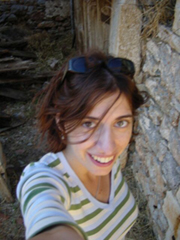Visualizing Voice
 Karrie Karahalios , University of Illinois
Karrie Karahalios , University of Illinois
kkarahal![]() cs.uiuc.edu
cs.uiuc.edu
Seminar on People, Computers,
and Design
Stanford University October 10, 2008
Audio communication research to date has been primarily dominated by work in the areas of speech recognition, transmission and compression, synthesis, computer music theory, and some music information retrieval. Looking at many research laboratories and universities, we tend to find audio processing groups focusing exclusively on the above areas.
In the area of Human Computer Interaction (HCI), research in audio is in the minority. For example, there are several textual search engines and even image search engines, yet barely a voice browser for public use. One reason is that a voice or audio browser relies heavily on speech recognition and audio classification which are not very accurate in general use scenarios. Given different speakers and different speaking environments, the problem becomes increasingly more difficult.
In this talk, we are taking a step back and looking at voice from a simpler perspective. We will show examples of conversational dynamics, retreaval through the use of a real time voice visualization on a tabletop, and examples of new interactions by using this interface as a social mirror.
![]()
Karrie Karahalios is an assistant professor in computer science at the University of Illinois where she heads the Social Spaces Group. Her work focuses on the interaction between people and the social cues they perceive in networked electronic spaces. Of particular interest are interfaces for pubic online and physical gathering spaces such as chatrooms, cafes, parks, etc. The goal is to create interfaces that enable users to perceive conversational patterns that are present, but not obvious, in traditional communication interfaces.
Karrie completed a S.B. in electrical engineering, an M.Eng. in electrical engineering and computer science, and an S.M. and Ph.D in media arts and science at MIT.
![]()
View this talk on line at CS547 on Stanford OnLine or using this video link.
Titles and abstracts for previous years are available by year and by speaker.